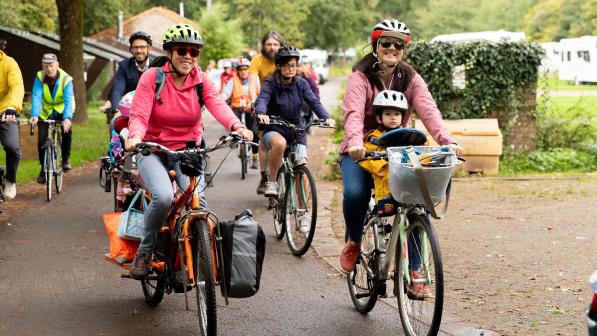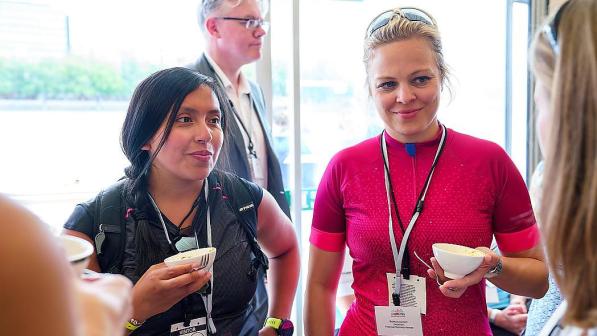Spokes & Votes: mobilising cycle advocacy for effective change

Rob Goodall, an Associate Director at Arup, leads the organisation’s active travel and local government work out of London. Stephen Bennett is a Director with the organisation and Transport Consulting Team leader; he is a specialist in transport decarbonisation.
With their extensive expertise, spanning local and regional strategies, multi-modal planning and infrastructure development, they took a good turnout of local cycling advocates through a webinar session which sought to explain how grassroots active travel groups can influence change.
Their ‘Spokes & Votes’ webinar was a collaborative exploration of how to harness local advocacy to transform active travel across the UK. The session unpacked the tools, policies and community strategies needed to shape healthier, cleaner and more sustainable transport networks.
Below, they share their expert strategies for effecting change at a local level.
Context, policy and the data driving change

The UK Government has set an ambitious target for half of all journeys in our towns and cities to be either cycled or walked. While this is a stretching, bold target, sitting behind it is the need for it to be focused through local delivery.
Although many journeys in the UK are short – with a significant number being under five miles – most people still rely on their cars. When working to raise the profile of interventions to increase levels of walking and cycling, it is useful to quote national-level statistics that demonstrate that:
- A large percentage of journeys made by people daily are very close to their homes.
- Cycling remains underutilised and walking is not as prevalent as it could be in everyday journeys.
It’s important to understand why this is the case and what government policy has been set to address these challenges. The government’s national policies such as the Cycling and Walking Investment Strategy (CWIS) and ambitious visions like Gear Change aim to reframe approaches to walking and cycling.
These initiatives are backed by significant government investment (although it could be more!) and updated guidance documents like Local Transport Note 1/20. This can and should be supported by calls to energise local policy frameworks that promote gender equity and inclusivity.
Techniques and engagement strategies

Influence is not simply a matter of policy: it’s about people. We have underlined several practical techniques for fostering change:
- Creating engagement strategies: clear, detailed plans that outline roles, responsibilities and accountability mechanisms are essential. By using feedback loops, leaders can track decision making and bolster commitment.
- Leveraging community walkabouts: site visits, led rides and even detailed study tours offer experiential insights that bring technical schemes to life while engaging local residents.
- Championing local voices: a recurring theme is the importance of identifying and empowering local champions – people with sway in the community or decision-making bodies. These advocates are often elected officials or influential community members who can help bridge the gap between technical proposals and public support.
Planning local cycling and walking infrastructure

A crucial part of the puzzle is to ensure that your local area has a plan. If it doesn't, it’s important to ask and understand why not. If your area doesn't have a developed Local Cycling and Walking Infrastructure Plan (LCWIP), putting one in place is a relatively standardised process. This strategic approach involves:
- Baseline reviews and network development: gathering key data – such as collision and cycle count data, demographic insights and existing route aspirations – is the first step.
- Ongoing stakeholder engagement: integrating community input from inception to execution ensures that schemes are both technically robust and socially acceptable. Good LCWIPs can easily be distinguished from poorer ones by how much input and engagement from local groups have been integrated into network planning and intervention identification.
- Formal adoption and publication: establishing clear documentation and publicly sharing the plan cements the initiative as a local priority.
Rural perspectives: bridging the urban-rural divide

While urban areas often receive the spotlight, it is important to understand the benefits to rural communities, too. Rural areas offer natural assets like green spaces and unique demographic opportunities. Yet, they also face:
- Greater distances for essential services.
- High levels of car dependency due to limited transport connectivity.
It is important that even in such settings, short everyday trips can be shifted to active travel modes, bringing health, environmental and economic benefits to these communities.
Success stories and real-world impact

If you're having trouble getting buy-in, nothing illustrates potential like concrete success stories and examples. We showcased several success stories including:
- Chelmsford’s Broomfield Road transformation: once plagued by congestion, this corridor now boasts a 100% increase in cycling, thanks to strategic improvements that also streamlined public transport operations.
- Barnsley, Doncaster, and the Loch Indaal Way: these case studies demonstrate how targeted interventions – ranging from removing barriers on trails to creating safe, traffic-free connections between communities – can lead to measurable increases in sustainable transport usage.
Showing the potential impact on alleviating local congestion issues, improving air quality and bringing economic growth are very difficult outcomes to argue against.
Tools, research and future support
For those ready to champion change, a wealth of tools and resources were highlighted:
- Guidance toolkits: free resources from organisations like Sustrans and Active Travel England offer extensive research and economic case studies.
- Interactive data portals: tools that visualise census data, cycle route priorities and budgeting benchmarks empower local planning efforts.
These digital assets help practitioners and advocates make fact-based, compelling cases for active travel.
Final thoughts: five keys to influence change
We believe that this can all be distilled into five actionable steps:
- Leverage existing context and policy: use the robust evidence and frameworks already at hand.
- Engage proactively: involve local stakeholders early and often.
- Identify a local champion: find that influential community leader who can drive the conversation.
- Build a fact-based case: ground your arguments in data, research and real-world successes.
- Focus on health and place-making: ultimately, better active travel schemes create healthier, cleaner and more vibrant communities.
By mobilising cycle advocacy and integrating these five approaches, communities can pave the way for fundamentally reimagined transport networks – a necessary step towards a more sustainable and inclusive future.

